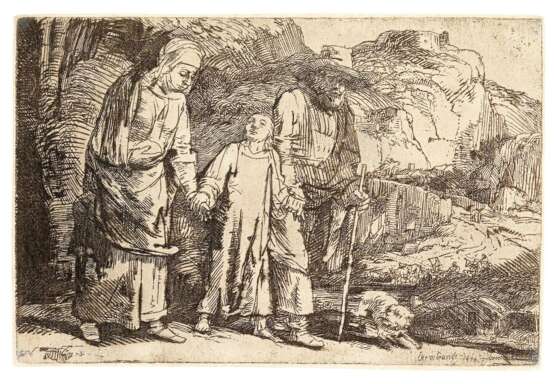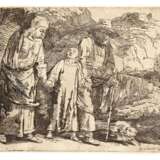ID 53056
Lot 70 | Rembrandt Harmensz van Rijn
Valeur estimée
€ 40 000 – 60 000
Jesus and His Parents returning from the Temple, 1654, etching and drypoint on fine Japan paper, signed and dated Rembrandt f 1654 in the plate, 9,5 x 14,4 cm, with narrow margins along platemarks, with a fine plate tone, Bartsch 60, White-Boon 60, New Hollstein 276 I ( von I ), mounted, unframed, ( Sch )
Provenance:
Academy of Fine Arts, Vienna (Lugt 2573 – mark of c. 1876); Collection Paul Davidsohn (1839-1931), Berlin, (Lugt 654), his auction, C. G. Boerner, Leipzig, 26th April 1921, lot 53; anonymous collection mark ("flower" not with Lugt); European private collection.
Excellent and clear impression of the only state with rich contrasts on Japan paper and with a fine plate tone. In excellent condition. Of utmost rarity.
The present etching is the last sheet of a series of small depictions with the life and childhood of Christ which Rembrandt executed in 1654 (compare New Hollstein 276-281). In the course of the scene’s reception the narrative was interpreted differently; either it was considered the Flight from or the Return to Egypt. Only in the 18th century the story was correctly assigned to the gospel of Saint Luke, according to which twelve-year old Jesus disappeared during the Passover festival and was found later by his parents among the doctors in the temple (Luke 2: 45 - 52): “When they did not find him, they went back to Jerusalem to look for him. After three days they found him in the temple courts, sitting among the teachers, listening to them and asking them questions. When his parents saw him, they were astonished. His mother said to him, “Son, why have you treated us like this? Your father and I have been anxiously searching for you.” Why were you searching for me?” he asked. ”Didn’t you know I had to be in my Father’s house?” But they did not understand what he wanted to say to them. Then he went down to Nazareth with them and was obedient to them. Rembrandt depicted the Holy Family on their return to Nazareth.
Young Jesus is walking between his parents, holding their hands; they are accompanied by a little dog. The depiction looks almost like an everyday family scene; the view is directed towards a bucolic landscape with a stone bridge and a small river in the right background and to a herd of cattle with shepherds. The scene is rendered with particularly atmospheric effects: The expressive drypoint hatchings and the strong chiaroscuro in the etched areas evoke a late afternoon mood of light.
The present etching is a splendid, early and very rare impression on Japan paper with deep ridges and a fine plate tone. Prints of this extraordinary quality are very rare to find on the art market which offered just twelve impressions in the last thirty years. Impressions on Japan paper, of which only a few ones are preserved in public and private collections, are even more difficult to find. Comparable impressions with a fine plate tone are preserved in the Kupferstichkabinett Berlin (Inv.6176–1878), in the Kunsthalle Bremen (Inv. 7325) and in the Albertina Museum in Vienna (Inv. DG1926/120).
The buyer‘s premium shall be as follows:
a) for items subject to margin tax (not specially marked in the catalogue/in the description) or for sales where the Dorotheum acts as an agent (marked with a “V” [“Vermittlung” = agent sale] in the catalogue/in the description):
■ up to an amount of EUR 100,000: 25% of the hammer price
■ for the amount exceeding EUR 100,000: 22%
■ for the amount exceeding EUR 600,000: 15%
In these cases the buyer‘s premium includes the statutory VAT
b) for fully taxable items (marked in the catalogue/in the description with the symbol „+“ for 20% VAT, with „–“ for 13% VAT or with „#“ for 10% VAT):
■ up to a hammer price of EUR 100,000: 20,84% of the hammer price
■ for the amount exceeding EUR 100,000: 18,34%
■ for the amount exceeding EUR 600,000: 12,5%
In the case under (b), the statutory VAT is calculated based on the total price (hammer price plus buyer‘s premium and a possible resale right royalty) and is added to the total price.
| Adresse de l'enchère |
Palais Dorotheum Dorotheergasse 17 1010 Wien Australie | ||||||||||||||
|---|---|---|---|---|---|---|---|---|---|---|---|---|---|---|---|
| Aperçu |
| ||||||||||||||
| Téléphone | +43 01 515600 | ||||||||||||||
| Fax | +43-1-515 60-443 | ||||||||||||||
| Conditions d'utilisation | Conditions d'utilisation | ||||||||||||||
| Modes de paiement |
Virement bancaire | ||||||||||||||
| Heures d'ouverture | Heures d'ouverture
|




